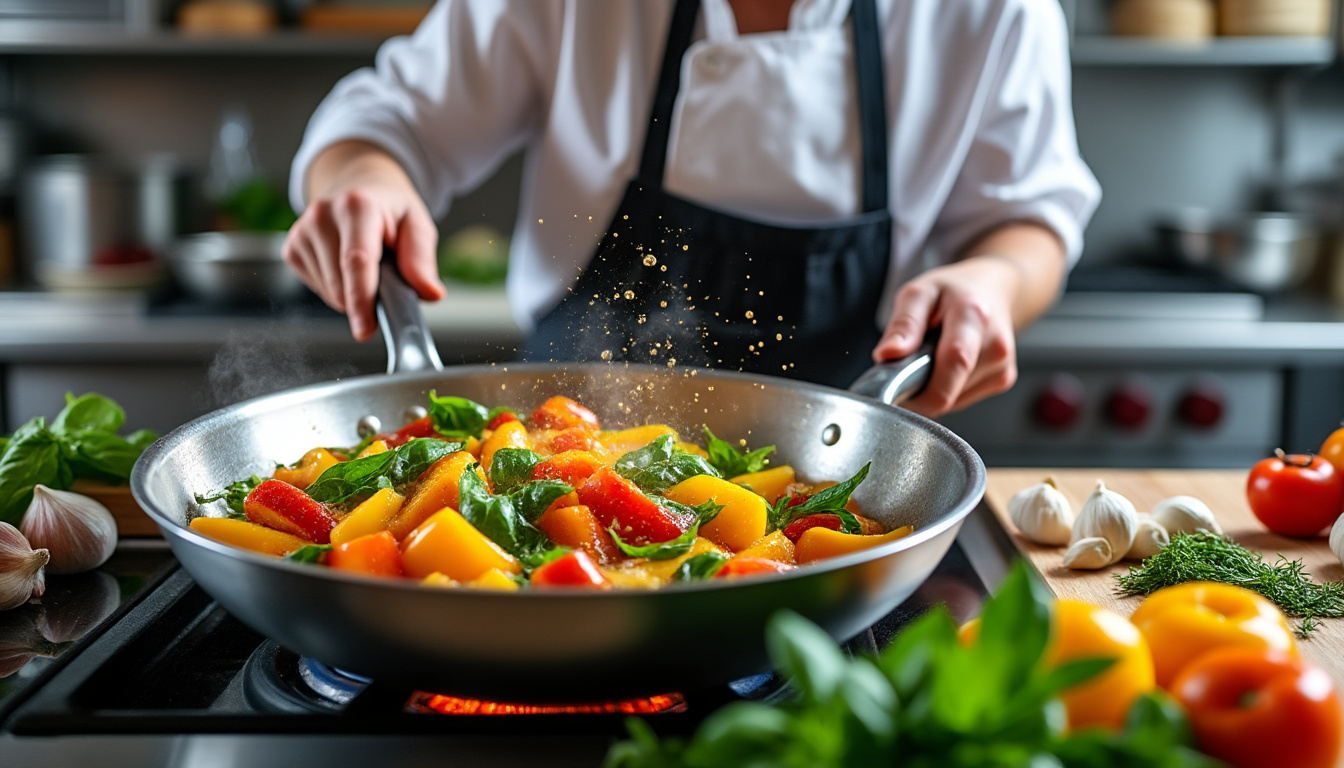Extra Virgin Olive Oil guide: evidence-based tips for cooking at high temperatures, safety, flavor impact, and best brands for frying and searing today.
Cooking with Olive Oil at High Temperatures remains a contested topic among chefs and nutritionists. This report clarifies myths about Extra Virgin Olive Oil, examines stability and smoke point data, and compares major brands to help home cooks choose the right oil for searing, pan-frying, and light deep-frying. Practical techniques, recipe links and brand notes accompany evidence-based arguments to guide everyday decisions.
Extra Virgin Olive Oil Safety at High Heat: Science Meets Practice
Evidence shows that Extra Virgin Olive Oil can be used safely at many high-heat home cooking temperatures because of its antioxidant content and fatty-acid profile. Concerns focus on smoke point and the formation of harmful compounds, but context matters: quality, refinement level and cooking method change outcomes.
- Key factor: high-antioxidant Extra Virgin Olive Oil resists oxidation better than many refined seed oils.
- Cooking window: sautéing and searing commonly stay below destructive thresholds for good-quality Extra Virgin Olive Oil.
- Practical tip: avoid sustained, extreme temperatures (open flames or oil smoking for minutes) to preserve flavor and nutrients.
Home kitchens benefit from monitoring pan temperature rather than banning the oil outright. For reliable recipes that use olive oil effectively, consult tested sources like Effortless Dinner Recipes and Chef’s Ultimate Pasta Recipes for practical examples.
| Brand | Type | Approx. Smoke Point | Best High-Heat Use | Notes |
|---|---|---|---|---|
| Pompeian | Refined / EVOO blends | 400–470°F | Searing, frying | Good value, refined blends for higher heat |
| Bertolli | Extra Virgin Olive Oil | 375–410°F | Sautéing, pan-frying | Consistent flavor; widely available |
| California Olive Ranch | Extra Virgin Olive Oil | 375–405°F | Searing, everyday cooking | High polyphenols in some batches |
| Filippo Berio | Extra Virgin / Pure blends | 370–430°F | Sautéing, light frying | Multiple grades; check label for intended use |
| Colavita | Extra Virgin Olive Oil | 375–405°F | Roasting, pan-searing | Balanced flavor, good for Mediterranean dishes |
| Goya Olive Oil | Refined / Extra Virgin | 370–440°F | High-heat stir-fry (refined) | Offers refined options for frying |
| Lucini | Extra Virgin Olive Oil | 360–400°F | Finishing, light searing | Pronounced flavor; best where taste matters |
| O-Live & Co. | Extra Virgin Olive Oil | 370–405°F | Everyday cooking, roasting | Good balance of stability and flavor |
| La Tourangelle | Infused / Light olive oils | 390–450°F | High-heat searing (light oils) | Artisanal blends, watch label for intended use |
Insight: selecting the right product—true Extra Virgin Olive Oil versus refined blends—determines performance at high heat.
Extra Virgin Olive Oil Smoke Point, Antioxidants and Stability
Smoke point figures vary by test method and batch. More important is the oil’s oxidative stability, driven by monounsaturated fats and polyphenols. High-antioxidant Extra Virgin Olive Oil can maintain lower harmful byproduct formation even when heated near its smoke point.
- Measure not myth: smoke point is a guide, not an absolute safety threshold for Extra Virgin Olive Oil.
- Antioxidant role: polyphenols help prevent oxidation during short, high-heat cooking bursts.
- Storage impact: fresh, well-stored Extra Virgin Olive Oil outperforms older, degraded oil at heat.
For technique-focused guidance that uses olive oil well, review tested recipes and methods such as those in Ina Garten dinner recipe and Ina Garten tomato dishes.
Insight: prioritizing antioxidant-rich Extra Virgin Olive Oil and proper pan control reduces risk and preserves flavor.
Extra Virgin Olive Oil Brands and Best Uses for High-Temperature Cooking
Brand choice influences suitability: some labels market refined or light olive oils specifically for higher-heat tasks, while many Extra Virgin Olive Oil products emphasize flavor over extreme heat tolerance. Understanding label language helps match oil to technique.
- When to choose refined or ‘light’ blends: for deep-frying or prolonged high-temperature frying, refined olive oils or blends from brands like Pompeian and Goya Olive Oil can be more practical.
- When to use Extra Virgin: searing, sautéing and roasting where flavor and antioxidants matter—brands such as California Olive Ranch, Colavita and O-Live & Co. excel.
- Premium flavor choices: Lucini and Filippo Berio are recommended for finishing dishes where taste is central.
Explore practical applications through recipe collections that integrate olive oil techniques, including Chef’s Guide to May Ingredients and Culinary Hacks & Cooking Skills.
After demonstration viewing, try targeted recipes like those in Chef’s Ultimate Pasta Recipes or weeknight solutions at Easy Meal Prep Recipes.
Insight: matching brand and product grade to the intended cooking method yields optimal flavor and safety from Extra Virgin Olive Oil.
Practical Techniques, Recipes and Household Tips Using Extra Virgin Olive Oil
Technique matters more than blanket rules. Moderate heat, preheating pans, and short cooking durations let Extra Virgin Olive Oil perform well. Practical examples and tested recipes illustrate safe, flavorful uses across cuisines.
- Sear then finish: start hot to create a crust, then lower heat and finish with a drizzle of Extra Virgin Olive Oil for aroma.
- Shallow frying: use refined olive oil blends for longer frying; reserve Extra Virgin Olive Oil for quick pan work.
- Roasting vegetables: coat in Extra Virgin Olive Oil and roast at moderate-high heat for caramelization without burning the oil.
For creative pairings and seasonal recipes that celebrate olive oil, consult inspiration from Culinary Chronicles Recipes and the foraged-ingredient series like Stinging Nettles Recipes.
Insight: simple technique adjustments unlock the culinary benefits of Extra Virgin Olive Oil while minimizing degradation.
Quick Reference Lists for Home Cooks
Short checklists help apply the guidance immediately in the kitchen.
- Buy: recent harvest, dark bottle, reputable brand (for example Filippo Berio or Lucini).
- Store: cool, dark place; avoid stove-top storage that accelerates oxidation of Extra Virgin Olive Oil.
- Use: EVOO for searing and finishing, refined blends for prolonged frying.
Insight: a short checklist reduces waste and improves results with Extra Virgin Olive Oil.
Practical Comparison Table and Final Notes on High-Heat Use
The table above summarizes brand tendencies and expected uses for high-heat cooking. When testing at home, a thermometer and small-scale trials reveal how a chosen bottle behaves in a specific pan and stove.
- Test method: warm oil gradually and note when smoke appears; that informs real-world practice for the current bottle.
- Flavor preservation: reserve the freshest Extra Virgin Olive Oil for finishing if a robust aroma is desired.
- Brand mix: combining a neutral frying oil with a drizzle of Extra Virgin Olive Oil can deliver both heat stability and flavor.
For more recipe-driven usage and inspiration, see curated collections such as Ina Garten dinner recipe and practical weeknight guides at Effortless Dinner Recipes.
Insight: practical, measured trials with the chosen bottle produce the safest and most flavorful results when cooking with Extra Virgin Olive Oil.
How to choose between brands quickly:
- Read label for “extra virgin” vs. “light”/”pure”.
- Check harvest or best-by date when available.
- Match product grade to the cooking task (searing, frying, finishing).
Key brands noted: Pompeian, Bertolli, California Olive Ranch, Filippo Berio, Colavita, Goya Olive Oil, Lucini, O-Live & Co., La Tourangelle.
Common Questions and Practical Answers
Is it safe to fry with Extra Virgin Olive Oil?
Yes—short-duration frying and searing with high-quality Extra Virgin Olive Oil is safe when pans are monitored and oil is not allowed to smoke extensively.
Will Extra Virgin Olive Oil lose health benefits when heated?
Some antioxidants decrease with heat, but many polyphenols remain and protect the oil; using Extra Virgin Olive Oil still offers better fatty-acid stability than many seed oils under comparable conditions.
Which brand is best for pan-searing?
Choose a high-polyphenol Extra Virgin Olive Oil from trusted producers like California Olive Ranch, Colavita or O-Live & Co. for balanced stability and flavor.
How to adapt a recipe that calls for olive oil?
Use refined olive oil or blends for long deep-frying; swap to Extra Virgin Olive Oil for finishing or quick sautéing to maximize taste.
Where to find tested recipes and technique guides?
Explore practical recipe and technique collections at Daily Bakersfield News: Culinary Secrets: TV Chefs, Culinary Chronicles Recipes, and Easy Meal Prep Recipes.

